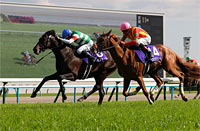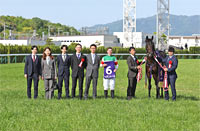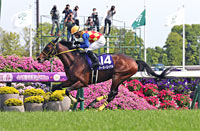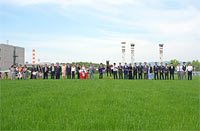2020 News
Fierement Closes Strongly to Defend Tenno Sho (Spring) TitleRace favorite Fierement showcased outstanding stayer talent to win the Tenno Sho (Spring) for the second time and is the first since Kitasan Black (2016 - 2017) and fifth in JRA history to claim the title consecutively. The 2018 Kikuka Sho (Japanese St. Leger, G1, 3,000m) winner was heavily beaten to 12th in his Prix de l’Arc de Triomphe (G1, 2,400m) challenge last season but bounced back to mark a fourth in the year-end Arima Kinen (G1, 2,500m) and this was his first start since. This victory marks trainer Takahisa Tezuka’s sixth JRA-G1 title, his latest was last year’s Tenno Sho (Spring), while jockey Christophe Lemaire has now 29 under his belt—his latest was the February Stakes with Mozu Ascot. Lemaire has already captured the autumn version of the Tenno Sho with Rey de Oro in 2018 and Almond Eye in 2019 which now makes him the first jockey ever to claim four Tenno Sho titles in a row. Danburite was sent to the front after a smooth break in the backstretch before Kiseki took over the lead the first time in front of the main stands. Under Christophe Lemaire, Fierement was unhurried near the rear, improving his position slightly to settle in the middle of the field which formed a long line up to the last turn. Still seventh heading into the lane right behind Mikki Swallow, Fierement unleashed a spectacular last three-furlong drive, catching You Can Smile in the last 50 meters and digging in well to draw even with Stiffelio right at the wire for a dramatic photo-finish. “The pace was ideal and I was almost sure it would be an easy win for us, but he wasn't focused at times, so as it turned out we had to fight hard to the line. But in spite of the long distance and the wide draw, he was unhurried earlier in the race and had the strength left to charge home the way he did—everything went well. I’m thankful to the fans rooting for us at home. I look forward to seeing them in the stands very soon,” commented Christophe Lemaire. Sent off 11th favorite, six-year-old Stiffelio broke well, sat in second behind Danburite earlier in the race and then third after Kiseki took over to set the pace, but was relaxed letting the two front runners stretch their leads. Entering the straight in the same order, the Stay Gold bay showed a good burst of speed easily taking over the lead by the furlong pole and held off a stubborn challenge by You Can Smile on the rails only to be caught at the wire by the eventual winner. Mikki Swallow was also unhurried in third to fourth from the rear and on the heels of Fierement. After gradually making headway down the backstretch, the fourth favorite was fifth to hit the straight, fought briefly to hold off the eventual winner but gave way 100 meters out but pinned You Can Smile right before the wire to notch a 2-1/2-length third. Other Horses: THE 161ST TENNO SHO (SPRING) (G1)
FP: Final Position / BK: Bracket Number / PP: Post Position / B: Blinker / S&A: Sex & Age / Wgt: Weight (kg) / L3F: Time of Last 3 Furlongs (600m)
Turnover for the Race alone: ¥ 16,870,966,000 Turnover for the Day: ¥ 26,016,703,500 PAY-OFF (for ¥100)
Winner= 10 starts, 5 wins, 2 seconds, 1 third / Added money: ¥ 153,024,000 / Career earnings: ¥ 573,059,000
* Tenno Sho (Spring) (G1) The forerunner of the Tenno Sho was established in 1905 under the name “Emperor’s Cup”, in which the winner received the silver comport bestowed by the Emperor. The race was renamed to “Teishitsu Goshoten Kyoso” the following year. The race became biannual events—held at Hanshin in spring and at Tokyo in autumn—a year after the establishment of the Japan Racing Society (the forerunner of the Japan Racing Association) in 1936, and was officially named the “Tenno Sho” since the autumn of 1947. The Tenno Sho (Spring) became the ultimate competition to determine the champion stayer, having altered its distance to 3,200 meters in 1938 while its counterpart in autumn run over 2,000 meters is one of the biggest middle-distance event contested between the proven older horses with the addition of the three-year-old hopefuls. The venue of the spring version was also moved to Kyoto Racecourse in 1948. The Tenno Sho (Spring) was designated as an international race in 2005 and welcomed Makybe Diva (GB, by Desert King) of Australia as the first foreign contender the same year. She finished seventh to Suzuka Mambo (JPN, by Sunday Silence) and subsequently went on to make history back home by winning her third consecutive Melbourne Cup (G1, 3,200m). Red Cadeaux (GB, Cadeaux Genereux) was the latest foreign contender of this race in 2014, running for the second time after finishing third in the 2013 edition, but was unable to perform over the firm turf and finished 14th. This year’s line-up featured defending champion Fierement for whom this was his first start of the 2020 season since marking a fourth in the year-end Arima Kinen (G1, 2,500m). Miraieno Tsubasa came off his first graded victory in the Diamond Stakes (G3, 3,400m; Feb.22). 2018 Kikuka Sho (Japanese St. Leger, G1, 3,000m) third-place finisher You Can Smile claimed another graded title in the Hanshin Daishoten (G2, 3,000m; Mar.22) followed by Tosen Cambina (2nd) and Meisho Tengen (3rd) while 2017 Kikuka Sho victor Kiseki was a disappointing seventh due to a poor break. Mikki Swallow registered his third grade-race win in the Nikkei Sho (G2, 2,500m: Mar.28) in which Mozu Bello and 2018 Kikuka Sho runner-up Etario were second and sixth, respectively. |
|




















